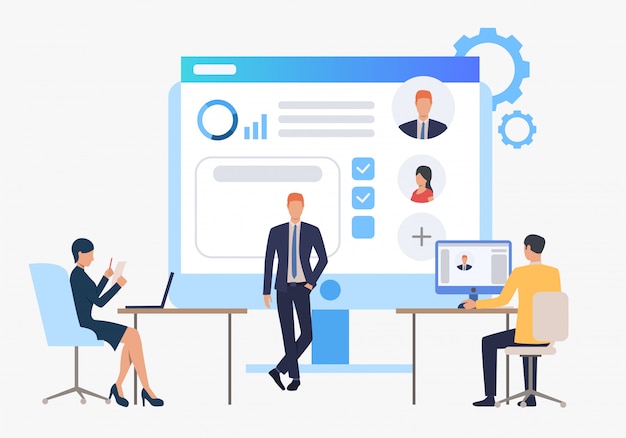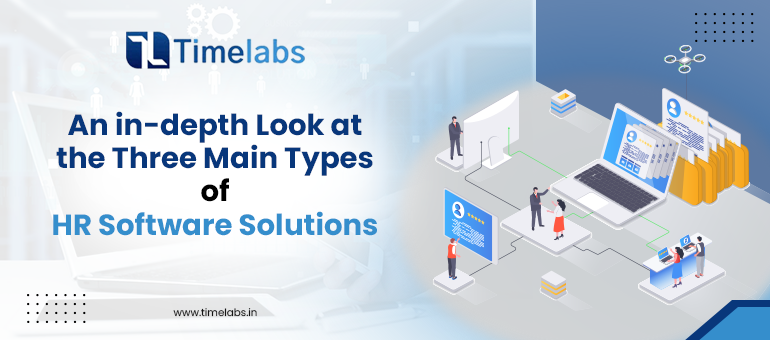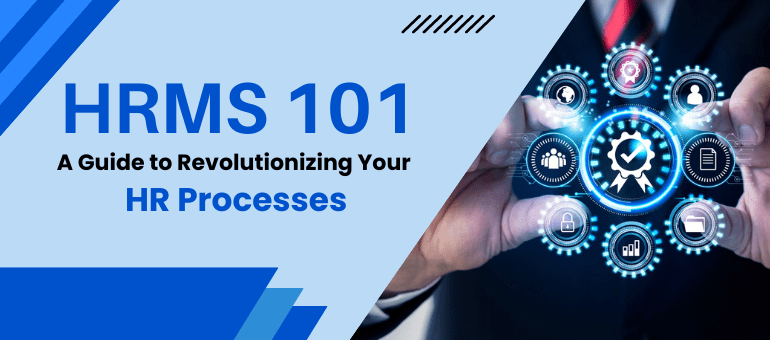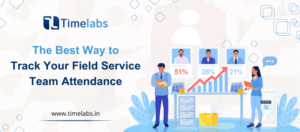Three Main Types of HR Software Solutions
With today’s focus on digitalization, Human Resources (HR) departments depend on new technologies to make their work easier and more efficient. Software solutions for human resources (HR) have become essential for all kinds of businesses because they provide a central location for managing various HR tasks. This detailed article talks about the three main types of HR software: Workforce Management Systems (WMS), Human Resource Management Systems (HRMS), and Talent Management Systems (TMS). We’ll go into detail about the pros and cons of each option so that you can make an informed decision about which one is best for your business.
Getting to Know HR Software
Sometimes called Human Resources Information Systems (HRIS), HR software is a complex set of programs designed to automate and improve a wide range of HR tasks. It helps HR teams do things like processing payroll and managing benefits more efficiently. It also helps with things like hiring, evaluating employees, and making sure they follow the rules. Human resource software gets rid of the need to do paperwork by hand, makes administration easier, and improves the accuracy and availability of data.
Human Resource Management Systems (HRMS)
The human resource management system (HRMS) is a type of HR software that has many functions. HRMS is a central place to manage employee data and automate HR workflows. It has many features, such as managing employee data, processing payroll and benefits, evaluating performance, helping with training and development, hiring and keeping track of applicants, and making sure compliance rules are followed.

Important Parts of HRMS
- Data Governance : HRMS lets HR teams organize and keep track of employee records that include personal information, work history, and performance reviews.
- Payroll Processing : The HRMS takes care of all the math behind payroll, including taxes, and sending accurate pay to employees.
- Benefits Administration : HRMS makes it easier to manage employee benefits like health insurance, retirement plans, and paid time off.
- Performance Review : HRMS makes it easier to review employees’ work, set goals, and keep track of their progress, which allows for quick feedback and action.
- Recruitment and Tracking of Applicants : An HRMS has tools for managing the whole recruitment process, from posting jobs and evaluating applicants to setting up interviews.
- Training and development : HRMS has learning management features that can help you plan training programs for employees, make sure they follow the rules for getting certified, and find skill gaps.
- Oversight of Compliance : HRMS helps companies follow legal requirements and rules by automatically keeping track of, reporting on, and storing compliance information.
Benefits of HRMS
- Operational Efficiency : HRMS automates HR tasks that require a lot of work, freeing up HR professionals to work on strategic projects instead of boring administrative tasks.
- Data Integrity : By putting all of the data in one place, HRMS makes sure that the data is correct and stops mistakes that can happen when people enter data by hand.
- Self-Service for Employees : The HRMS gives employees the power to see and change their personal information, look over their pay stubs, ask for time off, and take part in performance reviews.
- Compliance with regulations : HRMS helps people follow regulations by making it easier to keep track of compliance, check certifications, and report compliance.
- Reporting and analytical insights : HRMS gives reports and insights on workforce trends, performance indicators, and HR key performance indicators (KPIs), which helps people make decisions based on data.
Must read: Techniques for Efficient Remote Payroll Management in India
Talent Management Systems (TMS)
TMS is all about managing talent throughout all stages of their life in an organization. Through recruitment, onboarding, performance reviews, learning and development, succession planning, and career advancement, TMS aims to attract, nurture, retain, and engage top talent, which improves the organization’s performance.

Important Things About TMS
- Recruitment and Onboarding : TMS speeds up the steps needed to hire people, from posting jobs and choosing candidates to integrating new employees into the company’s culture.
- Performance Appraisal: TMS gives stakeholders the tools they need to set goals, keep an eye on performance, do appraisals, give feedback, and mentor others.
- Learning and Development : TMS uses learning management features to plan, give out, and keep an eye on programs for employee development.
- Succession Planning: TMS helps businesses find and train people who have the potential to be leaders in the future.
- Career Advancement: TMS helps employees plan their careers by giving them access to training resources, career path blueprints, and advancement views.
- Employee Engagement: TMS includes tools for getting feedback from employees, polling them, and measuring their levels of engagement and satisfaction.
Pros of TMS
- Talent Acquisition: TMS makes hiring faster, attracts top talent, and improves the experience of candidates.
- Performance Improvement : TMS encourages ongoing performance monitoring, feedback sharing, and coaching interventions, which leads to better work and more productivity from employees.
- Learning and Development : TMS encourages a culture of ongoing learning and development, which helps employees grow and makes them happier at work.
- Planning for Succession : TMS helps businesses find and train future leaders so that key positions are filled smoothly.
- Employee Engagement: TMS increases participation of employees by providing ways for advancement, recognition, and feedback requests.
Must read: A Recruitment Management System’s Significance in Organizing a Successful Recruitment Team
Workforce Management Systems (WMS)
The main goal of WMS is to improve scheduling, timekeeping, and labor analytics for workers. It helps businesses keep track of their employees’ work schedules, attendance, and leave requests more easily. WMS solutions are especially helpful for businesses that use shift-based labor models, which are common in manufacturing, healthcare, retail, and other industries.

Key Features of WMS
- Workforce Scheduling : WMS automates scheduling tasks, taking into account the availability, skills, and legal requirements of the workforce.
- Timekeeping and Attendance Tracking : The WMS keeps track of employees’ work hours, breaks, and absences, which makes it easier to do accurate payroll calculations.
- Leave Management : WMS makes it easier to ask for and approve time off, which makes sure that there is enough staff to cover all needs.
- Labor Analytics : Workforce Management Software (WMS) gives information about how productive workers are, how much they cost, and ways to make things better.
- Oversight for Compliance : WMS helps businesses follow the laws and rules about working hours and overtime.
Benefits of WMS
- Efficient Workforce Scheduling : WMS optimized workforce scheduling, reducing labor costs and making sure the best staffing allocations.
- Precision in Payroll Processing : WMS accurately records employees’ work hours, breaks, and leaves, which makes it easier to accurately pay them.
- Leave Management : WMS speeds up the process of applying for and approving leave, which reduces scheduling conflicts.
- Labor Analytics : WMS gives businesses information about how efficient their workers are, so they can find places to improve and make the best use of their workers.
- Compliance: Work Management Software (WMS) helps companies follow the laws and rules about working hours, breaks, and overtime.
Must read: The Definitive Guide for Selecting a Saas-based Cloud Payroll Software
Selecting the Apt HR Software Solution
When embarking on the selection of an HR software solution for your organization, it is imperative to contemplate specific requisites, financial considerations, and scalability imperatives. The following factors merit consideration:
- Organizational Scale and Complexity : The magnitude and intricacy of your enterprise dictate whether a comprehensive HRMS or specialized solution is warranted.
- Functional Prerequisites : Discern the HR functionalities necessitating automation and ascertain alignment with the software solution’s offerings.
- Integration Capabilities : Assess the software’s compatibility with extant HR and payroll systems, as well as its integrative prowess with ancillary business applications.
- Vendor Reputation and Support : Conduct due diligence on the vendor’s repute, customer testimonials, and support infrastructure to ensure a dependable alliance.
- Scalability : Opt for a solution poised to accommodate your organization’s growth trajectory and evolving HR exigencies.
- User Experience : Evaluate the software’s user interface and intuitiveness, as it directly influences user adoption and satisfaction.
- Data Security and Compliance : Assure robust data security protocols and compliance with pertinent data protection edicts.
Advantages of HR Software Implementation
The deployment of an HR software solution confers manifold benefits upon enterprises, irrespective of their size or sector. Key advantages include:
- Process Streamlining : HR software automates manual HR tasks, trimming administrative overheads and fostering operational fluidity.
- Data Precision and Access : Centralized data repositories underpin data integrity, preempting duplications, and elevating data accessibility.
- Regulatory Compliance : HR software facilitates adherence to labor laws, statutes, and reporting requisites.
- Augmented Employee Self-Service : HR software empowers employees to administer personal data, peruse remuneration statements, and solicit leave.
- Data-Informed Decision-Making : HR software furnishes real-time analytics and insights, galvanizing data-centric HR strategies and resolutions.
- Enhanced Employee Experience: HR software expedites HR workflows, affords self-service utilities, and amplifies communication, engendering superior employee satisfaction.
- Cost and Time Economies : HR software diminishes manual paperwork, eliminates duplicates, and automates labor-intensive tasks, culminating in cost and time savings.
Must read: Top Priorities for HR Leaders in 2024
Premier HR Software Providers
In the quest for an HR software solution, it is paramount to align with a reputable vendor offering robust support and ongoing product evolution. The following are acclaimed HR software providers:
- Timelabs : Timelabs proffers a holistic HR payroll software suite in India, encompassing recruitment, onboarding, employee self-service, and ancillary HR automation solutions.
- Workday : Workday extends a cloud-based HRMS solution embracing a gamut of HR functions encompassing management, payroll, benefits administration, and talent management.
- SAP SuccessFactors : SAP SuccessFactors proffers a suite of cloud-based HR solutions spanning talent management, performance management, learning and development, and workforce analytics modules.
- BambooHR : BambooHR delivers an instinctive HR software solution tailored for small and medium-sized enterprises, integrating applicant tracking, performance management, and employee data governance.
- Oracle HCM Cloud : Oracle HCM Cloud furnishes a comprehensive HRMS solution amalgamating HR, talent management, and workforce management functionalities within a unified cloud framework.
Future Trajectories in HR Software
As technological vistas continue to expand, HR software solutions evolve in tandem to address the mutating exigencies of enterprises. Emerging trends in HR software encompass:
- Artificial Intelligence (AI) and Machine Learning : AI and machine learning integrations within HR software automate routine tasks, refine data analytics, and optimize decision-making.
- Employee Experience Platforms : Employee experience platforms pivot on enriching employee engagement, wellness, and productivity through personalized experiences and self-service features.
- Mobile and Cloud Solutions : HR software solutions are increasingly mobile-responsive and cloud-centric, catering to the burgeoning remote workforce and mobile device ubiquity.
- People Analytics : HR software harnesses data analytics to furnish enterprises with insights into workforce dynamics, performance metrics, and prognostic talent management.
- Integration with Diverse Business Applications : HR software fosters integration with ancillary business applications such as customer relationship management (CRM) and enterprise resource planning (ERP) systems, enhancing data interoperability and cross-functional synergy.
Must read: Boosting ROI Through Empathetic HR Technology
In Conclusion
HR software solutions have catalyzed a paradigm shift in HR management, engendering streamlined workflows, enhanced data integrity, and enriched employee experiences. By discerning the three primary categories of HR software solutions – HRMS, TMS, and WMS – enterprises can navigate judiciously to identify the bespoke solution aligning with their unique imperatives. Whether aiming to automate payroll processing, fortify talent management endeavors, or optimize workforce scheduling, a befitting HR software solution beckons. Embrace the transformative potential of HR technology to propel efficiency, compliance, and employee engagement across organizational HR echelons.



